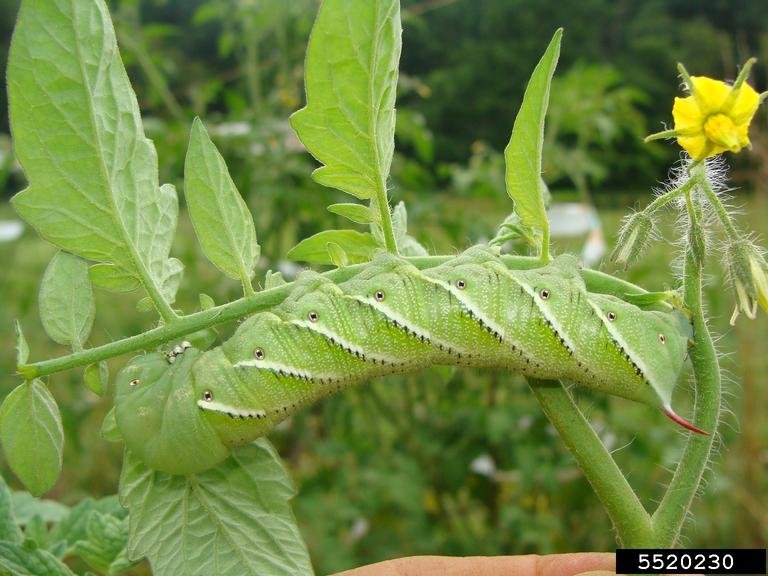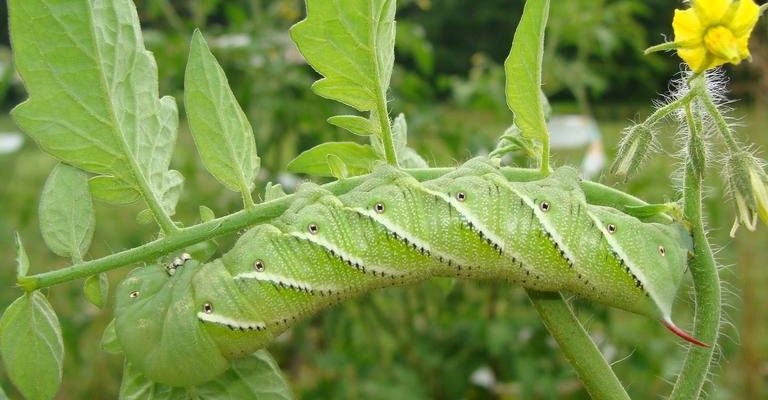
Now, you might be scratching your head, wondering why a single caterpillar could have such an impact on a whole garden’s profitability. Well, it’s all about balance. Just as a missing ingredient can spoil a recipe, the presence of hornworms can throw off the delicate ecosystem of a market garden, leading to financial consequences that ripple through the entire operation.
What Are Hornworms and Why Do They Matter?
Hornworms, particularly the ones you might find munching on your tomatoes, are the larvae of the moth species known as the Five-spotted Hawkmoth. They can grow up to 4 inches long and are often a bright green color, making them camouflaged against the plants they love to feast on. This sneaky appearance is how they can cause so much damage without you even noticing right away.
Hornworms are not just hungry; they can devour the leaves, stems, and even the fruit of your plants, leading to **significant crop loss**. Imagine spending weeks nurturing your plants only to find them being eaten overnight by these voracious caterpillars. The result? A decrease in yield that can hurt your bottom line. Market gardeners rely heavily on healthy, thriving plants to keep their businesses flourishing, making hornworms a notable threat.
In addition to direct plant damage, hornworms can introduce other issues. For instance, their presence might encourage more pests or diseases, which could lead to further financial strain. When you’re managing a market garden, maintaining plant health is key, and hornworms can throw a wrench in those plans.
The Economic Toll of Hornworm Infestations
So, what does a hornworm infestation actually mean in terms of dollars and cents? Well, let’s break it down. First, consider your lost crops. If hornworms munch through a few plants, that’s a loss of potential sales. With tomatoes, for example, if one hornworm takes out 10 plants, and each plant could’ve produced 10-15 tomatoes, you’re looking at a substantial financial hit.
Then there’s the cost of **control measures**. Market gardeners often invest in pesticides or organic pest control methods to tackle hornworm problems. Each product has its price, and when you add this to the labor costs of applying these treatments, you might find your expenses have ballooned.
Lastly, let’s not overlook the emotional toll. Watching your hard work being destroyed can be disheartening. This psychological aspect can impact productivity and motivation, indirectly influencing your bottom line. The stress of managing hornworms may lead to rushed decisions or poor management practices, ruining the future health of your garden.
Preventing Hornworm Damage in Market Gardens
The good news is that there are several strategies to help prevent hornworm damage. One effective method is **crop rotation**. By changing the location of your crops each season, you can disrupt the life cycle of these pests, making it harder for them to establish themselves.
Another strategy is to **encourage natural predators**. Birds, wasps, and other insects can help keep hornworm populations in check. Consider creating a welcoming environment for these beneficial creatures by planting flowers and herbs that attract them. You might even want to introduce certain species of wasps that specifically target hornworms, serving as nature’s own pest control.
Lastly, keep a vigilant eye on your plants. Regular inspections can catch hornworms in their early stages before they cause too much damage. If you spot them, you can remove them by hand or use organic pesticides as necessary. Remember, early intervention can save you a whole lot of trouble later.
Organic vs. Chemical Control Measures
When it comes to dealing with hornworms in market gardens, you have a couple of paths to choose from: organic methods and chemical controls. Let’s weigh the pros and cons of both.
**Organic controls** tend to be safer for the environment and your health. You might use neem oil, for example, which disrupts the hornworms’ feeding and growth. Or, you could try diatomaceous earth, which damages the exoskeletons of pests. While these methods might take longer to work, they can be very effective and keep your produce safe from harmful chemicals. Plus, some customers prefer organic products, which can increase your market appeal.
On the flip side, **chemical pesticides** can offer rapid results. If you’re in a pinch and facing a significant infestation, they may be tempting. However, these products often come with hefty caution labels, and overuse can lead to pesticide resistance in the long run. Many consumers today are looking for fresh produce that hasn’t been treated with harsh chemicals, which can limit your marketability.
Ultimately, the choice comes down to your gardening philosophy and the specific needs of your market garden. Whichever route you choose, it’s essential to follow instructions carefully and prioritize safety.
Impact on Crop Diversity
Crop diversity plays a vital role in the resilience of market gardens. When you plant a variety of species, it can help minimize the chance of a total crop loss from pests like hornworms. Think of it like a diversified investment portfolio; if one plant suffers, others can help balance out your overall yield.
For example, suppose your garden includes tomatoes, peppers, and squash. If hornworms target the tomatoes, you still have peppers and squash to fall back on. This approach not only helps maintain your income but also contributes to overall ecosystem health. It creates a more balanced environment, which can naturally deter pests.
Moreover, planting companion plants can further enhance this diversity. Certain plants can repel hornworms or attract beneficial insects that prey on pests. Using this natural approach not only supports your financial health but also contributes positively to the environment.
The Role of Education and Support Networks
As a market gardener, staying informed is crucial. Joining gardening clubs or online communities can provide valuable insights on managing pests like hornworms. Sharing experiences and tips with fellow gardeners can help you develop effective strategies tailored to your specific situation.
Local agricultural extension services can also be a fantastic resource. They often offer workshops and seminars on pest management, including hornworms. Here’s the thing: education isn’t just about learning; it’s about empowering yourself to make informed decisions.
Additionally, reaching out to seasoned gardeners can provide mentorship opportunities. These relationships can lead to shared resources, such as pest control products or even labor help during peak seasons. Collaboration often leads to stronger community ties and a healthier market garden overall.
In summary, hornworms can have a significant economic impact on market gardens. Their ability to quickly damage crops can lead to financial losses that extend beyond just what’s visible. However, with the right strategies—like prevention methods, choosing effective control measures, and fostering community support—you can mitigate these effects.
You might feel overwhelmed at times, but remember that you’re not in this alone. By prioritizing education and staying vigilant against these pests, you can safeguard your market garden and keep it thriving. The goal is to enjoy the fruits of your labor, both literally and figuratively, without the threat of hornworms hanging in the background. Happy gardening!

